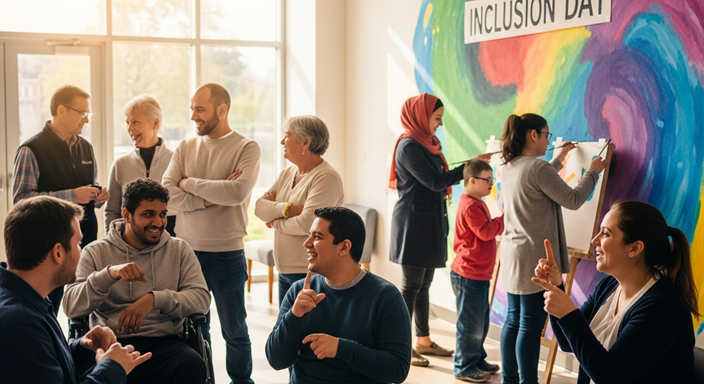Every human being deserves to feel #seen, #respected, and #valued—no matter their #background, #ability, #identity, or #circumstance. #InclusionDay is a day to #honor that powerful idea: #inclusion. On this special day, people and communities across the #globe pause to #reflect, #raise awareness, and act to build societies where every individual truly belongs.
History of Inclusion Day
Inclusion Day, sometimes referred to as World Inclusion Day, is celebrated annually on October 10.
The day was founded in 2020 by Taylor Gardner Chaney, through her nonprofit, The Garden Foundation.
The inspiration came from a desire to expand the notion of inclusion—not only for persons with disabilities, but across all forms of diversity (race, gender, religion, culture, socioeconomic status, etc.).
Because it is a relatively new observance, documentation on earlier milestones is limited. Over the years, more organizations, schools, governments, and communities have adopted it as a day to celebrate and push for inclusive practices.
Importance of Inclusion Day
The core reason behind observing #InclusionDay is to spotlight the universal need for belonging and equitable participation. Societies are still rife with barriers—whether physical, social, systemic, or attitudinal—that exclude or marginalize groups. Inclusion Day offers a focal moment to confront those obstacles, to promote awareness, and to motivate change.
Some key importance elements:
-
Visibility & Voice: It gives visibility to underserved or marginalized groups whose stories and experiences often go unheard.
-
Awareness & Education: It provides a platform for educating people about different kinds of diversity (disabilities, cultural, linguistic, gender, etc.) and the value of inclusive environments.
-
Catalyst for Action: It encourages individuals, institutions, and governments to adopt policies, practices, and mindsets that foster inclusion rather than exclusion.
-
Solidarity & Empathy: By uniting people in a common purpose, it nurtures empathy, compassion, and understanding across difference.
-
Cultural Shift: Over time, repeated emphasis on inclusion helps shift norms—so that inclusive behavior becomes everyday behavior, rather than a periodic initiative.
Significance of Inclusion Day
Beyond the importance, the significance of the day lies in its symbolic and practical roles.
-
Symbol of Hope and Progress: It signals that the ideal of inclusion is not just theoretical, but a goal to actively pursue.
-
Benchmark and Checkpoint: Each year, communities can gauge how far they’ve come in making their spaces more inclusive—and where gaps remain.
-
Bridge-Building: It forges connections among groups of different identities, disabilities, cultures, and backgrounds, inviting cross-dialogue and relationship.
-
Inclusion as Norm, Not Exception: By naming and celebrating inclusion, the day reinforces that inclusion should be baked in automatically—not tacked on as a special accommodation.
-
Momentum for Policies and Reform: Governments and institutions may use the day to launch or recommit to inclusive legislation, accessibility reforms, or equity initiatives.
Why Inclusion Day Is Celebrated
We celebrate Inclusion Day because:
-
To affirm dignity and equality — Every individual deserves to be treated with dignity and fairness, regardless of who they are or where they come from.
-
To dismantle exclusion — Societies often erect invisible or visible barriers (discrimination, prejudice, inaccessible spaces). Celebration is also protest: it challenges those barriers.
-
To inspire real change — Celebrations spark conversations, commitments, and action.
-
To connect communities — People across sectors (education, business, health, government) can come together around the shared value of inclusion.
-
To sustain attention — Even when daily challenges distract us, inclusion needs consistent attention—and a dedicated day helps maintain focus.
How Inclusion Day Is Celebrated
Inclusion Day is celebrated in diverse ways—tailored to local contexts, resources, and communities. Some common forms:
-
Awareness Campaigns & Social Media: Use of hashtags (e.g. #WorldInclusionDay, #InclusionMatters) to share stories, facts, pledges, videos, and personal reflections. (Impactful Ninja)
-
Inclusive Workshops, Seminars & Talks: Events hosted in schools, universities, workplaces, community centers focusing on themes like equity, access, implicit bias, universal design, etc.
-
Art, Performances & Storytelling: Inclusive cultural programs—music, dance, theatre, spoken word—centered on diversity and belonging.
-
Accessibility Audits & Policy Launches: Organizations may assess their physical, digital, and policy-level inclusion, or unveil new inclusive strategies.
-
Symbolic Gestures: Wearing inclusive colors (for example, orange is used in some local “Inclusion Day” events such as for developmental disability awareness) (summitdd.org)
-
Inclusive Activities: Inviting persons with disabilities or from marginalized groups to co-lead events, inclusive sports, unified teams combining diverse participants, co-creative sessions, etc.
-
Pledges and Commitments: Individuals and institutions publicly make promises (e.g. to adopt inclusive hiring, accessibility, respect) and share progress.
-
Partnering with NGOs and Disability / Equity Forums: Collaborations with organizations working on inclusion helps scale reach and impact.
Where Is Inclusion Day Celebrated?
Because it is a newer global observance, participation is still growing. However:
-
Globally, many countries and communities acknowledge October 10 as World Inclusion Day or host inclusion-related events.
-
United States: Schools, nonprofits, local governments adopt it; special education departments schedule inclusion activities (e.g. MPUSD scheduling inclusive activity at 10:10 a.m. on Oct 10).
-
International Organizations & NGOs: The Garden Foundation promotes participation across borders.
-
Within Sub-Communities: Some communities in the U.S. use a separate “Inclusion Day” for Developmental Disability awareness (e.g. Summit County, Ohio) in March (distinct from the global Oct 10).
-
Selected Schools, Universities, Corporations Worldwide: Many educational institutions, global firms, and NGOs adopt inclusion events, seminars, campaigns aligned with October 10.
-
Regional Adaptations: In regions where October 10 might conflict with local holidays or climatic conditions, some may shift or add local inclusion events at other times.
Thus, while not universal in the sense of every country officially designating it, its reach extends across continents through civil society, educational and corporate adoption.
How Citizens Get Involved & Make It a Success
Inclusion Day is not just for institutions—ordinary citizens play a central role. Here’s how people can contribute:
-
Educate Yourself & Others
Read up on inclusion, diversity, disability rights, intersectionality. Share learnings with family, friends, colleagues. -
Use and Amplify Your Voice
On social media, share your own experiences or posts celebrating inclusion using relevant hashtags. Support the voices of marginalized people by amplifying their stories. -
Attend or Organize Local Events
Whether a school, library, community center, or workplace, host talks, film screenings, discussion circles, inclusive games, art projects. -
Small Acts of Inclusion
Invite someone into your group who’s often excluded, listen to perspectives different from yours, make accessibility adaptations in your environment, use inclusive language. -
Advocate for Inclusion
Engage local government, educational institutions, or employers to adopt inclusive practices—accessible infrastructure, inclusivity policies, reasonable accommodations. -
Volunteer or Support NGOs
Join or donate to organizations working on disability rights, equity, inclusion, social justice. Help with outreach, event execution, or mentoring. -
Make Personal Commitments & Track Progress
Set personal or team goals (for instance, “In my team, ensure every meeting has an inclusive check,” or “I will educate myself on disability inclusion by year-end”) and report back after the day. -
Collaborate Across Sectors
Form coalitions: citizens, NGOs, schools, businesses, faith communities working together amplify impact.
By layering individual action with institutional shifts, citizens help make #InclusionDay more than symbolic—it becomes a seedbed for longer-term change.
Theme for Inclusion Day 2025
At present, there is no widely publicized, official global theme for World Inclusion Day 2025 (as of available records). However, many organizations are aligning with broader themes of “Inclusion Matters” or “Inclusion for All” to stress universality beyond a single dimension.
Local hosts or institutions may choose their own theme (e.g. “Belonging in Every Space”, “Uniting Strengths in Diversity”).
If a theme is announced later by The Garden Foundation or a coordinating body, many participants will tailor their activities around it.
If you like, I can research whether a theme has been confirmed for 2025 and share it.
10 Famous Quotes for Inclusion Day
These quotes on inclusion, belonging, diversity, and unity may resonate on #InclusionDay:
-
“We all do better when we all do better.” — Paul Wellstone
-
“Diversity is being invited to the party; inclusion is being asked to dance.” — Vernā Myers
-
“Inclusion is not a matter of political correctness. It is the key to growth.” — Jesse Jackson
-
“Our ability to reach unity in diversity will be the beauty and the test of our civilization.” — Mahatma Gandhi
-
“You are only completely yourself when you are connected to everyone.” — Margaret J. Wheatley
-
“Belonging is a feeling you get when you are seen, heard, and valued.” — Unknown
-
“Strength lies in differences, not in similarities.” — Stephen R. Covey
-
“We cannot all succeed when half of us are held back.” — Malala Yousafzai
-
“Inclusion is not tolerance — it is unquestioned acceptance.” — Unknown
-
“When we listen and celebrate what is both common and different, we become a wiser, more inclusive, more interesting people.” — Pat Wadors
FAQs (Frequently Asked Questions)
Q1. What is the official date of Inclusion Day?
A. Globally, World Inclusion Day is celebrated on October 10 every year.
Q2. Is Inclusion Day only about disability?
A. No. While disability inclusion is a central dimension, the concept deliberately spans all kinds of diversity—race, gender, religion, culture, socioeconomic status, language, sexual orientation, age, and more.
Q3. Who can participate in Inclusion Day?
A. Anyone—individuals, schools, NGOs, governments, corporations—anyone who believes in belonging, respect, equity, and inclusion.
Q4. Is there a fixed theme for 2025?
A. Not yet publicly confirmed (based on available sources). Many participants continue to use general themes like “Inclusion Matters.”
Q5. How can small communities with limited resources celebrate?
A. With creativity: storytelling circles, open dialogues, low-cost art projects, shared meals with mixed participants, inclusive games, taking small inclusion pledges, or collaborating with local NGOs.
Q6. Do all countries officially recognize it?
A. No. It is not (yet) a formal international holiday recognized by all governments, but many civil society actors, institutions, and organizations globally observe it.
Q7. Can organizations launch policies on that day?
A. Yes—and many do. Inclusion Day is often a moment to unveil inclusion strategies, accessibility upgrades, training programs, or equity commitments.
Q8. How to measure impact of Inclusion Day?
A. Possible indicators: attendance numbers, social media reach, number of pledges, follow-up actions, policy adoptions, increased awareness (surveys), growth in inclusive practices post-event.
Q9. Do other “Inclusion Days” exist (e.g. in disability awareness)?
A. Yes. For example, some U.S. communities celebrate an “Inclusion Day” in March connected to developmental disabilities awareness (e.g. Summit County)
Q10. How to keep the spirit beyond one day?
A. By embedding inclusion in routine practices—annual checks, inclusive designs, ongoing training, accountability metrics, and continuous listening to marginalized voices.
Conclusion
In a world often fractured by difference, #InclusionDay reminds us of a profound truth: inclusion is not a luxury, but a foundational human need. When people feel seen, welcomed, and valued, we unlock the greater potential of our communities. Though it is still a new observance, its power lies in the shared commitment it fosters—to tear down barriers, to listen more deeply, and to co-create spaces of true belonging.
Let Inclusion Day not remain just a symbolic date on the calendar. Let it be a springboard—sparking sustained action, policy change, and cultural shift. May 2025’s celebration ripple forward, turning the ideal of inclusion from aspiration to everyday reality.
|
!!! Stay Updated !!! 👉 Follow and Join us on 👈 📰 Trending News | 📢 Important Alerts | 💼 Latest Jobs LinkedIn | Threads | Facebook |Instagram | Tumblr 📱 Follow us daily & never miss an update 📱 |

Someshwar Chowdhury is a seasoned Chartered Mechanical Engineer, Educator, and Technology enthusiast with over a decade of experience in engineering education and consultancy. Someshwar is also an active blogger, trainer, and member of professional bodies like ISHRAE and GREEN ADD+. When not teaching or consulting, he enjoys blogging, music, and exploring green technologies.
Discover more from Today's Significance
Subscribe to get the latest posts sent to your email.
